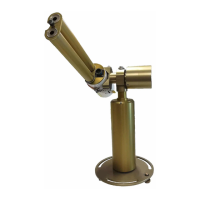CE318-T Photometer
User Operation Manual
Revision V4.10 October 2021
75
2. What does the calibration process consist in?
The calibration consists in a sky calibration by inter-comparison with an integrating
sphere and a sun calibration by inter-comparison with master photometers.
3. What is the best place to put the photometer?
The photometer should be positioned in a place sheltered from the wind if possible and
with an open sky, meaning that it will be able to track the sun without any obstacle from
sunrise to sunset. If possible, a RS232 link will be installed for transfer data to a PC.
The cable length should not exceed 100m.
4. Can I replace components myself?
Components can be replaced by the owner after diagnosis has been established by
CIMEL technical support. Never try to replace a component by yourself without CIMEL
approval. However, the sensor head should never be disassembled as it will unset the
sky and sun calibrations.
5. What are the first things to do when I notice that the photometer is
down?
The first things to do when the photometer is down is to put back the photometer in
manual mode and launch a PARK scenario, until the first investigations and diagnosis
can be done.
6. What are the main outputs of the photometer?
The main output of the photometer is the calculation of the optical depth (AOD) which
is an important atmospheric parameter as it is linked to the aerosol concentrations in
the sky. Others output values are calculated if the instrument is in the AERONET
network or similar networks.
7. What happens when the wet sensor is activated?
As soon as the wet sensor is activated, the photometer stops its measures and goes
to the ORIG position to avoid water accumulation on the sensor head lenses and inside
the collimator.

